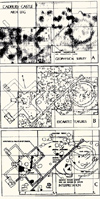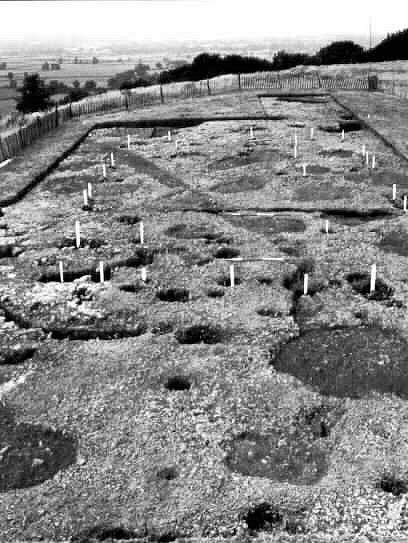
Archaeology
Local people also believed that King Arthur and his knights slept in a hidden cave beneath the hillfort. When archaeological research first began there, an old man from the village asked anxiously if the excavators had come to remove the King.
And whatever the people of the neighbourhood were saying in 1542, they have certainly cherished Arthurian lore since then. Cadbury Hill has its version of the cave-legend, which, in fact, can be documented earlier than any other, as far back as the 16th century:
"Arthur lies asleep in a cavern closed by iron gates, or maybe golden ones. Sometimes they open so that the fortunate wanderer can glimpse him inside."
A party of Victorian archaeologists were asked by an old man if they meant to dig up the king.
"There is a well on the left of the path as you go up: it is Arthur's Well, and the highest part of the hill is Arthur's Palace", a phrase on record as early as 1586. Another story tells u that on Midsummer Eve, or Midsummer Night, or Christmas Eve (opinions differ, and some say it is only every 7th year), Arthur and his knights ride over the hilltop and down through the ancient gateway, and their horses drink at a spring beside Sutton Montis church; whether or not they can be seen, their hoof beats can be heard." Below the hill are traces of an old track running towards Glastonbury, called Arthur's Lane or Hunting Causeway, where a noise of spectral riders and hounds goes past on winter nights.
Excavations
1913 - H. St. George Gray
He excavated mainly near the south-west entrance, finding objects which showed that people were on the hill in the late Iron Age just before the Roman conquest.
c. 1955 - Mary Harfield & Dr. Raleigh Radford
She was a local archaelogist who picked up flints and potsherds which appeared on the surface in the upturned soil, when a part of the enclosure was ploughed. She asked the help of dr. Radford and he recognized pottery of the type he had found at Tintagel, which proved that somebody had lived here at about the time of Arthur, and most likely a "somebody" of wealth and standing who could import luxury goods. The interest thus aroused led to the formation of the Camelot Research Committee, which carried out large-scale excavations in 1966/70 under the direction of Leslie Alcock.
1965 - The Camelot Research Committee
 Encouraged by the foundings of dr. Radford and with the help of Leyland's notes, the CRC started excavating large areas of the South Cadbury Hillfort and the results were copious.
It became clear that British Celts of the Iron Age had not only built the earthwork defenses, but reconstructed the top bank several times, as Rev. Bennett already suspected. A village flourished on the plateau for hundreds of years. Then the Romans stormed Cadbury and evicted the survivors, resettling them at the foot of the hill so that they could not make it a strong point in any future rebellion. During most of the Roman period the enclosure was empty. However, a temple may have been built during a pagan revival which is known to have spread through Britain in the 4th centuryCE. After that comes a phase of total obscurity, and after that, the Arthurian period. For this the archaeological haul was richer than anyone had expected, or dared to predict.
 In a central and commanding position, on the high part of the hill called 'Arthur's Palace', the foundations of a timber hall came to light. It was 63 x 34 ft. and its walls were marked by post-holes cut in the bedrock. A trench running across it, closer to one end than the other, showed where a partition had divided it into large and small rooms. In outline it resembled the hall at Castle Dore, but there were grounds for inferring more skillful workmanship, quality rather than size. In this building the chief warriors would have assembled, feasted, listened to minstrels, planned campaigns. A smaller building close by could have been the kitchen, and others may also have belonged to an Arthurian complex, though it was only with the hall that dating was certain. In a central and commanding position, on the high part of the hill called 'Arthur's Palace', the foundations of a timber hall came to light. It was 63 x 34 ft. and its walls were marked by post-holes cut in the bedrock. A trench running across it, closer to one end than the other, showed where a partition had divided it into large and small rooms. In outline it resembled the hall at Castle Dore, but there were grounds for inferring more skillful workmanship, quality rather than size. In this building the chief warriors would have assembled, feasted, listened to minstrels, planned campaigns. A smaller building close by could have been the kitchen, and others may also have belonged to an Arthurian complex, though it was only with the hall that dating was certain.
At the south-west entry were the remains of a gatehouse of the same period. A cobbled road (10 ft. wide) climbed into the enclosure. It passed through double doors into a nearly square wooden tower, and out through similar doors the other side.
All this, of course, has now been buried again and only the gap in the bank is visible, far shallower than it was. Most important of all was the discovery which was made in that bank, the three-quarter-mile perimeter of the hill. Cuts through it in several places, now refilled like the entrance, revealed a cross-section like a layer cake, with strata one above another showing how the rampart had been rebuilt at various times over the centuries. In Arthurian times it had been rebuilt grandiosely. On top of the earth at that level was a dry stone bank or wall 16 ft. thick. Gaps where ancient timber had rotted marked the places where massive posts had upheld a breastwork on the outside, protecting men who stood on the wall. Beams had run across, binding the structure together and supporting a platform, and perhaps, at intervals, wooden watch towers.
Arthurian index
|











